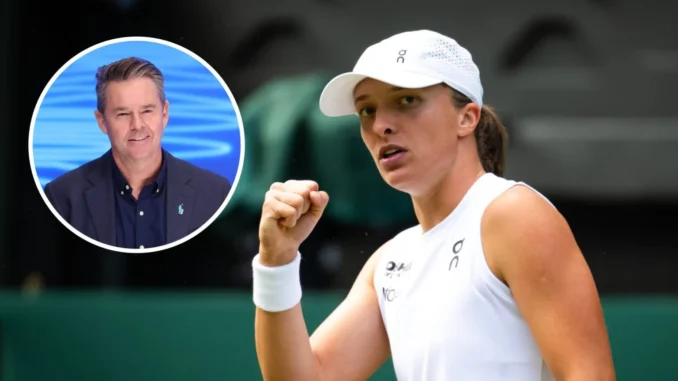
In a dazzling display of dominance, Iga Swiatek stormed to her first Wimbledon title in 2025, leaving an indelible mark on the All England Club with a 6-0, 6-0 rout of Amanda Anisimova in the final. The 24-year-old Pole’s clinical performance, which lasted just 57 minutes, not only secured her sixth Grand Slam title but also drew a striking comparison from Australian tennis legend Todd Woodbridge to the iconic Steffi Graf, a 22-time Grand Slam champion. “Iga was relentless,” Woodbridge remarked, noting that Swiatek’s commanding presence on Centre Court mirrored Graf’s unyielding intensity during her storied career. This historic victory, the first Wimbledon women’s final double bagel since 1911, cemented Swiatek’s place among tennis’s elite and sparked conversations about her potential to rival the sport’s greatest.
Swiatek’s journey to Wimbledon glory was a testament to her resilience and adaptability. Known as the “Queen of Clay” for her four French Open titles, she had long struggled on grass, with her best prior result at Wimbledon being a 2023 quarterfinal. Her 2025 season had been turbulent, marked by a doping controversy, a coaching change to Wim Fissette, and a dip to world No. 8 after failing to defend her Roland Garros crown. Yet, Swiatek’s preparation for Wimbledon was meticulous. After reaching the final at Bad Homburg, where she fell to Jessica Pegula, she honed her grass-court game in Mallorca, focusing on movement and serving. “I think she got a bit hectic at the start of the season. Now something is different and she has a bit more patience with herself,” said former player Andrea Petkovic, who predicted Swiatek’s triumph after spotting a “new freshness” in her play.
On Centre Court, Swiatek was unstoppable, dropping just one set throughout the tournament—against Caty McNally in the second round—before steamrolling opponents like Belinda Bencic in the semifinals (6-2, 6-0) and Anisimova in the final. Her serving, which she called “the best it has been in the entire grass-court swing,” was a key weapon, with 79% of first-serve points won, the joint-second highest in the draw. “It seems super surreal,” Swiatek said, reflecting on her victory. “Honestly, I didn’t even dream of winning Wimbledon because it was way too far.” Her ability to shape high topspin forehands and break sidelines with cross-court backhands overwhelmed Anisimova, who managed only nine points and committed 28 unforced errors. “I think I was a little bit in shock after,” Anisimova admitted, but vowed, “I’ll definitely come out stronger after this.”
Woodbridge’s comparison to Graf, shared on the podcast *The Tennis*, highlighted Swiatek’s relentless returning and tactical maturity, qualities that defined Graf’s 377 weeks as world No. 1. “Iga for so long would come out like Steffi Graf and just positively bounce around and hit winners and dominate,” Woodbridge noted, recalling Graf’s ability to overpower opponents with precision and aggression. Swiatek’s 6-0, 6-0 victory, the first such result in a Wimbledon final since Dorothea Lambert Chambers in 1911, echoed Graf’s 1988 French Open double bagel over Natasha Zvereva, the only other Open Era Grand Slam final with such a scoreline. Swiatek’s win made her the eighth woman in the Open Era to claim majors on all three surfaces—clay, hard, and grass—following in the footsteps of Graf, Serena Williams, and Ashleigh Barty.
The significance of Swiatek’s triumph extends beyond the court. After a challenging year, including a one-month doping ban in 2024 for a contaminated melatonin supplement, she showed remarkable mental fortitude. “The lesson is just that even when you feel like you’re not on a good path, you can always get back to it if you put enough effort and you have good people around you,” Swiatek said, crediting her team, including Fissette and her father, Tomasz, a former Olympic rower. Her victory, celebrated by peers like Coco Gauff, Rafael Nadal, and Billie Jean King, and even a hug from actress Courteney Cox, underscored her growing influence. Polish football star Robert Lewandowski called her “amazing,” reflecting national pride in her historic achievement as the first Polish woman to win Wimbledon.
Swiatek’s sixth major moves her past Maria Sharapova and Martina Hingis, with only 10 women in the Open Era boasting more. At 24, she’s the second-youngest this century to win majors on all three surfaces, trailing only Serena Williams, who achieved the feat at 20. With an Australian Open title the final piece needed for a Career Grand Slam, Swiatek’s trajectory suggests she could approach Graf’s 22 majors, though Woodbridge noted she’d need to accelerate her pace to match that tally before her 40s. As Swiatek prepares for the 2026 season, her Wimbledon masterclass, likened to Graf’s relentless brilliance, signals a player ready to redefine tennis greatness, one dominant performance at a time.
Leave a Reply